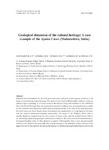Geological dimension of the cultural heritage: A case example of the Ajanta Caves (Maharashtra, India)

Ver/
Use este enlace para citar
http://hdl.handle.net/2183/14752Coleccións
Metadatos
Mostrar o rexistro completo do ítemTítulo
Geological dimension of the cultural heritage: A case example of the Ajanta Caves (Maharashtra, India)Data
2015Cita bibliográfica
Cadernos Laboratorio Xeolóxico de Laxe, 2015, 38: 69-79 ISSN:0213-4497
Resumo
[Abstract]International development for the both geoconservation and geotourism requires attention to all
kinds of (potential) geological heritage. The Ajanta Caves (western Maharashtra, India) is a famous
cultural object consisting of 30 caves carved in the Deccan Traps and inscribed to the UNESCO
list of the World Heritage Sites. Its examination permits to indicate four geological features, which
are the artificial caves themselves (these mark geological activity of the man in the historical past),
the end-Cretaceous flood basalts (these demonstrate the emplacement of Large Igneous Province
and the relevant palaeoenvironmental catastrophe), the gorge of the Waghora River (this is peculiar
landform resulted from the river erosion of hard rocks), and the rockfall hazard (this is
an interesting engineering geological phenomenon linked to the caves construction/maintenance).
Geological heritage value of these features is argued. Unfortunately, there is not any geotourism
activity at the Ajanta Caves presently. The content analysis of the principal on-line resources (web
pages) devoted to this cultural site reveals the absence of sufficient geological information that would
68 Gontareva, E.F et al. CAD. LAB. XEOL. LAXE 38 (2015) facilitate geotourism. Generally, judgements about
the Ajanta Caves and the other similar sites in the geological dimension permit to consider the wide
spectrum of the geological heritage. They also highlight some extra opportunities for geotourism, which
can benefit by its development at cultural sites with thousands of visitors.
Palabras chave
Ajanta Caves
Deccan basalts
Geological heritage
Geotourism
World Heritage Site
Deccan basalts
Geological heritage
Geotourism
World Heritage Site
ISSN
0213-4497





